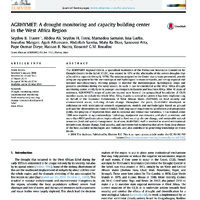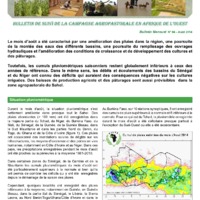Recherche
3 items
AGRHYMET: Adrought monitoring and capacity building center in the West Africa Region
The AGRHYMET Regional Center, a specialized institution of the Permanent Interstates Committee for Drought Control in the Sahel (CILSS), was created in 1974 at the aftermaths of the severe droughts that affected this region in the early 1970s. The mission assigned to the Center was to train personnel, provide adequate equipment for the meteorological and hydrological stations networks, and set up regional and national multidisciplinary working groups to monitor the meteorological, hydrological, crops and pastures conditions during the rainy season. As such, it can be considered as the West Africa drought monitoring center, similarly to its younger counterparts in Eastern and Southern Africa. After 40 years of existence, AGRHYMET’s scope of activities expend now beyond the geographical boundaries of CILSS member states, to include the whole West Africa thanks to several initiatives it has been implementing on behalf of the Economic Commission of West African States (ECOWAS) on food security and environmental issues, including climate change. Throughout the years, AGRHYMET developed, in collaboration with international research organizations, models and methodologies based on ground and satellite observations to monitor rainfall, food crop water requirements satisfaction and prospective yields, the progress of vegetation front and its seasonal and interannual variations. It has trained about 1200 new experts in agrometeorology, hydrology, equipment maintenance, and plant protection, and more than 6000 professionals on topics related to food security, climate change, and sustainable natural resources (land and water) management. As of now, AGRHYMET staff is involved in several international initiatives on climate change, food security, and environmental monitoring that allow them keep abreast of the best available technologies and methods, and also contribute to generating knowledge on those issues.
Bulletin de suivi de la campagne agropastorale en Afrique de l’ouest août 2014
Le mois d’août a été caracterisé par une amélioration des pluies dans la région, une poursuite de la montée des eaux des différents bassins, une poursuite du remplissage des ouvrages hydrauliques et l’amélioration des conditions de croissance et de développement des cultures et des pâturages. Toutefois, les cumuls pluviométriques saisonniers restent globalement inférieurs à ceux des années de référence. Dans le même sens, les débits et écoulements des bassins du Sénégal et du Niger ont connu des déficits qui auraient des conséquences négatives sur les cultures irriguées. Des baisses de production agricole et des pâturages sont aussi prévisibles dans la zone agropastorale du Sahel.
Intégrer le Changement climatique dans le processus de budgétisation
Formation sénégal intégration du cc dans politiques et stratégies - m5b
L’aide budgétisée luxembourgeoise au Sénégal


